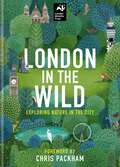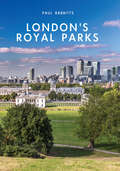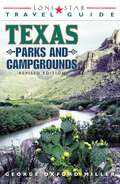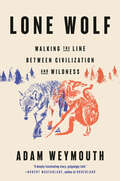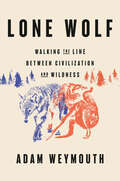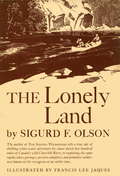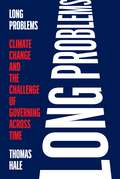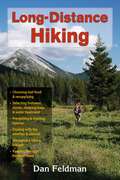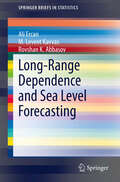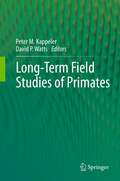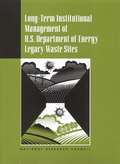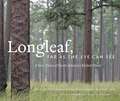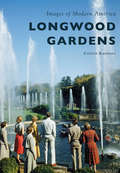- Table View
- List View
London in Bloom
by Georgianna LaneJoin acclaimed photographer Georgianna Lane and explore the flower markets, gardens, and floral boutiques of London in this full-color celebration of the flora of England’s capital. London in Bloom showcases the floral abundance of the city’s extraordinary parks, gardens, florists, and flower markets. In this companion to her popular books Paris in Bloom and New York in Bloom, Georgianna Lane takes us on a romantic floral tour of London, juxtaposing luscious blooms with intricate floral details found in iconic architecture. The book also includes: A detailed list of recommended parks, gardens, markets, and floral designers A spring tour of blossoms and blooms A field guide of common spring-blooming trees and shrubs Step-by-step instructions for creating a London-style bouquet And more Lane offers a practical travel guide for anyone planning to see London in bloom in real life. She plans out a tour of spring blossoms, with a field guide for identifying flowering trees and shrubs. She even includes a list of addresses for her favorite parks, gardens, floral boutiques, and flower markets. Lane writes, “No place, real or imagined, enchants quite like an English garden. The ornate gates, the tumbling roses, the winding paths, and the sunlight winking through branches of delicate blossoms have long inspired poetry and romance. . . . Some are intimate and secret, with secluded corners and mysterious pools where dragonflies hover or fantastic creatures might even dwell. Others are impressive and majestic, their rolling parklands reminiscent of an eighteenth-century landscape painting.” For flower lovers and Anglophiles alike, London in Bloom offers a unique and irresistible view of London, a chance to bring “poetry and romance” to your home or to give it as a gift.
London in the Wild: Exploring Nature in the City
by London Wildlife Trust'London in the Wild is a timely opportunity to get out and explore all the wild spaces and natural places that exist alongside us. Both on your doorstep and on the other side of the river.' - Chris Packham A place of cars, concrete, lights, noise and pollution, London is a harsh, unyielding landscape created to meet the needs of people, not wildlife, but if you take the time to stop and look, you'll discover it is teeming with more than 15,000 species of flora, fungi and fauna, including marsh frogs, hedgehogs, short-eared owls and dragonflies. With London in the Wild as your guide, you can explore the city from your garden, local parks and community space, but also from its wetlands, woodlands and heaths. Along the way you'll discover the best places to see bluebells in springtime, the day-to-day life of a London Tube mouse and the activities of seals who make their home in the Thames.
London in the Wild: Exploring Nature in the City
by London Wildlife Trust'London in the Wild is a timely opportunity to get out and explore all the wild spaces and natural places that exist alongside us. Both on your doorstep and on the other side of the river.' - Chris Packham A place of cars, concrete, lights, noise and pollution, London is a harsh, unyielding landscape created to meet the needs of people, not wildlife, but if you take the time to stop and look, you'll discover it is teeming with more than 15,000 species of flora, fungi and fauna, including marsh frogs, hedgehogs, short-eared owls and dragonflies. With London in the Wild as your guide, you can explore the city from your garden, local parks and community space, but also from its wetlands, woodlands and heaths. Along the way you'll discover the best places to see bluebells in springtime, the day-to-day life of a London Tube mouse and the activities of seals who make their home in the Thames.
London is a Forest
by Paul WoodExploring the rich diversity of London through a series of urban forest trails, this new, expanded edition of London is a Forest uncovers the fascinating stories and secrets the city holds.Through seven carefully devised paths, author Paul Wood explores the urban forest's geography, its past and future, and looks at the remarkable variety of life supported in this unique metropolitan ecosystem. For curious Londoners and anyone who’s fascinated by nature, a wealth of arboreal details, history, myth and anecdotes are revealed along the way. Complementing the trails, Wood looks in more detail at the fascinating stories of some of the iconic, and some of the less obvious species that define the urban forest.In London, 9 million people are crammed into just 600 square miles alongside 8.5 million trees. According to one UN definition, this makes the city a forest. The Forestry Commission agree, describing London as the world’s largest urban forest. And a particularly diverse and historic urban forest at that.
London is a Forest
by Paul WoodCan a city be a forest? At first glance, this does not chime with our childhood idea of the ‘wild wood’ – a dark entanglement of trees, where humans fear to tread. But a forest does not need to be dense and impenetrable, and it’s not unheard of for people to live in them either.In London, 8.6 million people are crammed into just 600 square miles alongside 8.3 million trees, and millions upon millions of other plants, insects and animals. According to one UN definition, this makes the city a forest. The Forestry Commission agree, describing London as the world’s largest urban forest. And it’s a very special, urban forest at that.Following a number of trails through the rich diversity of London, this book looks closely at the urban forest, our relationships with it and attitudes towards it and will uncover the fascinating stories and secrets it holds.Through these paths that meander through the urban forest, author Paul Wood explores its geography, its past and future, and looks at the remarkable variety of life supported in this unique metropolitan ecosystem. From the edgelands to the beating heart of the clamorous 21st century megacity, a wealth of arboreal details, history, legend and anecdotes will be revealed along the way. You’ll discover some of the species found here, and the people who have helped to shape this remarkable environment over many centuries.Complementing the trails, Wood looks in more detail at the fascinating stories of some of the iconic, and some of the more hidden species that define the urban forest. These include familiar tree species like the London Plane, Oaks, Cherries and Hornbeam, alongside the rare Wild Service Tree and the surprising Tree of Heaven. Other inhabitants of the forest such as parakeets, urban foxes and, of course, humans are also featured.
London's Lost Rivers: a beautifully illustrated guide to London's secret rivers
by Paul TallingPacked with surprising and fascinating information, London's Lost Rivers uncovers a very different side to London - showing how waterways shaped our principal city and exploring the legacy they leave today. With individual maps to show the course of each river and over 100 colour photographs, it's essential browsing for any Londoner and the perfect gift for anyone who loves exploring the past...'An amazing book' -- BBC Radio London'Talling's highly visual, fact-packed, waffle-free account is the freshest take we've yet seen. A must-buy for anyone who enjoys the "hidden" side of London -- Londonist'A fascinating and stylish guide to exploring the capital's forgotten brooks, waterways, canals and ditches ... it's a terrific book' - Walk'Pocket-sized, beautifully designed, illustrated and informative - in short a joy to read, handle and use' -- ***** Reader review'Delightful, informative and beautifully produced' -- ***** Reader review'A small gem. A really great book. I can't put it down' -- ***** Reader review'Fascinating from start to finish' -- ***** Reader review************************************************************************************************From the sources of the Fleet in Hampstead's ponds to the mouth of the Effra in Vauxhall, via the meander of the Westbourne through 'Knight's Bridge' and the Tyburn's curve along Marylebone Lane, London's Lost Rivers unearths the hidden waterways that flow beneath the streets of the capital. Paul Talling investigates how these rivers shaped the city - forming borough boundaries and transport networks, fashionable spas and stagnant slums - and how they all eventually gave way to railways, roads and sewers. Armed with his camera, he traces their routes and reveals their often overlooked remains: riverside pubs on the Old Kent Road, healing wells in King's Cross, 'stink pipes' in Hammersmith and gurgling gutters on streets across the city. Packed with maps and over 100 colour photographs, London's Lost Rivers uncovers the watery history of the city's most famous sights, bringing to life the very different London that lies beneath our feet.
London's Royal Parks
by Paul RabbittsThis book tells the history of London's royal parks and how they have evolved from private hunting grounds and gardens into public spaces and venues for great events. In some cases, the parks were royally owned as long ago as the Norman conquest, and several of them were acquired by Henry VIII during the Reformation. At this time they were kept private and there was no public access, but during the eighteenth century most of the parks were opened to the public. Landscaping work was undertaken to keep up with trends, and the parks became fashionable places to be seen out and about - witness Rotten Row in Hyde Park. The parks, Hyde Park in particular, has been used to host major events such as the Great Exhibition and various jubilee and entertainment events. It tells the story of each of the nine royal parks from their acquisition by the monarchy through to the present day, outlining their use and management and the major historical moments associated with them.
Londonwalks
by Anton PowellLondon, a huge,sprawling metropolis, does not reveal itself to the casual visitor. To discover its diffuse wonders you must investigate its streets and squares on foot. Shunning major sights and typical tourist attractions, Londonwalks guides you through four of the most historic areas of the city's center, offering up bits of history, telling stories about unmarked houses and royal scandals, discussing architectural details, exposing relics. Easily completed in a morning or afternoon, each walk mentions plenty of spots along the way to read, rest, snack or browse. With maps, photos, a helpful section of information and advice, an index of important names, and a selected list of restaurants, pubs and shops, Londonwalks is a discriminating companion for the newcomer and for the veteran, who will learn something new about London with almost every step.
Lone Star Field Guide to Texas Snakes
by Alan TennantThe State of Texas not only boasts the largest snakes in North America, but also the largest number of species—105. This guide describes in detail each and every one of them, from the benign Texas long-nosed snake, to the venomous Western Cottonmouth. Facts on the biology and behavior are given, plus the latest findings on abundance, reproduction, prey, sizes, and habitat. In addition, introductory chapters describe the physiology and diet of snakes, and an all-important section on "Venom and Evenomation" debunks the many myths surrounding what to do when bit by a venomous snake. 128 color plates of species and subspecies aid in identification.
Lone Star Guide to Texas Parks and Campgrounds
by George Oxford MillerThis up-to-date guidebook is just the ticket for campers, hikers, mountain bikers, horseback riders, birdwatchers, nature photographers, and folks who just like to enjoy the outdoors. It offers all the details to every state and national park, recreation area, national forest, and historical park in Texas. Where appropriate, maps are provided to identify specific campsites within the larger parks, and "at a glance" charts provide a quick and easy way to determine the extent of such amenities as showers, flush toilets, electricity, etc. The unique features of each park or campground are described, as well as the recreation available, be it boating or bird watching. Whether it's for a Saturday getaway or a two-week vacation, this handy book is a great guide to outdoor fun in Texas.
Lone Wolf: Walking the Line Between Civilization and Wildness
by Adam WeymouthAn illuminating account of one wolf's journey across the Alps into Italy, and what the resurgence of wolves says about our connection to nature, immigration, and one another—from an award-winning journalist.In 2011, a wolf named Slavc left his home territory of Slovenia for a wide-ranging journey across the Alps. Tracked by a GPS collar, he traveled over 1,200 miles, where he would mate with a female wolf on a walkabout of her own—the only two wolves for hundreds of square miles—and start the first pack to call the Italian Alps home in more than a century. A decade later and there are more than a hundred wolves in the area, the result of their remarkable meeting. Now, journalist Adam Weymouth follows Slavc's path on foot, and in doing so, interrogates the fears and realities of those living on land that is being repopulated by wolves; a metaphor for economic, political, and climate upheaval in a region that is seeing a centuries-old way of life being upended. Weymouth journeys to understand how wolves—vilified throughout history in literature, art, and folklore—are slowly creeping back into our forests, woods, and sometimes even our towns, and what that deep-rooted terror at the back of our minds really means. Slavc serves as the ultimate symbol for the outsider, journeying through places that are now wrestling with an influx of immigration, a resurgence of the far-right wing, and the steady decline of the environment due to the rapid advance of climate change; the question of how we see the other and treat the earth becomes paramount in everyday lives. Examining the political dimensions that this individual animal's trek brings to light, Lone Wolf tells a newly resonant story—one less about fear and more about the courage required to seek out a new life, as well as the challenge of accepting the changing world around us.Sharply observed, searching, and written in poetic and precise prose, Lone Wolf explores the thorny connection between humans and nature, and indeed between borders themselves, and presses us to consider this much-discussed creature anew.
Lone Wolf: Walking the Line Between Civilization and Wildness
by Adam WeymouthAn intimate account of an epic walking journey through a tense and shifting Europe in the footsteps of one extraordinary wolf.In the winter of 2011, a young wolf, named Slavc by the scientists who collared him, left his natal pack's territory in Slovenia, embarking on what would become a two thousand kilometre trek to northern Italy. There, he found a mate—named Juliet—and they produced the first pack in the region in a hundred years. A decade later, captivated by Slavc's journey, Adam Weymouth set out to walk the same route. As he made his way through mountainous terrain, villages and farmland, he bore witness to the fears and harsh realities of those living on the margins of rural society at a time of deep political and social flux, for whom the surging wolf population posed an existential threat. In Lone Wolf, Weymouth interrogates how the wolf—loved and loathed, vilified and romanticized throughout history—is re-emerging in wild and cultivated landscapes; how the borders between us and them are slipping away; and what our deep-rooted fear of the mysterious creature really means.Sharply observed, searching, poetic and revealing, Lone Wolf is a story of wildness and of the human desire for order in an ever-evolving world.
Lonely Land
by Sigurd F. OlsonThe Lonely Land is a tribute to the unspoiled beauty of the deep wilderness and the rugged individuals past and present who take up a canoe paddle to explore it.
Long Beach Wild
by Adrienne MasonEach year, more than a million people visit the spectacular sweep of sand that stretches along Vancouver Island's west coast between Tofino and Ucluelet to watch waves crash ashore on a series of beaches-essentially one long beach separated by small rocky headlands, a shoreline steps away from howling wolves and towering red cedars.In Long Beach Wild: A Celebration of People and Place on Canada's Rugged Western Shore, local resident Adrienne Mason uses her intimate knowledge of the area and a selection of historic and contemporary photos to explore the region's rich natural and cultural history.Mason shows how Long Beach was shaped by many forces, including volcanoes, glaciers, and torrents of water. She describes how the deposits of gravel and silt that this tumult left behind allowed offshore kelp beds and sea otters to thrive and supported the growth of countless other organisms, from lichens and ferns to waterfowl and deer.She also describes how First Nations people found inspiration and sustenance in the area for thousands of years, hunting whales on the open ocean using harpoons with mussel-shell blades and great lengths of cedar bark rope.As well as describing the traditions of the area's First Nations, Mason
Long Island Sound
by James S. Latimer Mark A. Tedesco R. Lawrence Swanson Charles Yarish Paul E. Stacey Corey GarzaThe U. S. Ocean Commission Report identified the need for regional ecosystem assessments to support coastal and ocean management. These assessments must provide greater understanding of physical and biological dynamics than assessments at global and national scales can provide but transcend state and local interests. This need and timeliness is apparent for Long Island Sound, where a multi-state regional restoration program is underway for America's most urbanized estuary. Synthesis of the Long Island Sound ecosystem is needed to integrate knowledge across disciplines and provide insight into understanding and managing pressing issues, such as non-point sources of pollution, coastal development, global climatic change, and invasive species. Currently, there is a need for a comprehensive volume that summarizes the ecological and environmental dynamics and status of Long Island Sound and its myriad ecosystems. It has been 30 years since a comprehensive summary of Long Island Sound was prepared and 50 years since the pioneering work of Gordon Riley. Major advances in estuarine science are providing new insights into these systems, and yet, the condition of many estuaries is in decline in the face of continuing coastal development. There is an opportunity to lay a foundation for integrative coastal observing systems that truly provide the foundation for improved decision-making. This book will provide a key reference of our scientific understanding for work performed over the past three decades and guide future research and monitoring in a dynamic urbanized estuary.
Long Island State Parks: A History from Jones Beach to Montauk (Landmarks)
by Kristen MatejkaDiscover the History Behind the Beauty of Long Island's Most Cherished Parks Each year, tens of millions of people visit Long Island's state parks. Most visitors are unaware that each one of the state parks has its own fascinating chapter in the region's storied history. Some were once vast estates of New York's elite during the turn-of-the-century Gilded Age, such as Planting Fields Arboretum State Historic Park. Others were "hunting clubs," where wealthy members banded together to create retreats, including Caleb Smith State Park Preserve. Montauk's Camp Hero has a multigenerational military history, even inspiring conspiracies that the government experimented with mind control and time travel. Underprivileged children from the bustling boroughs of New York City found fresh air and formative experiences at Camp William Carey in today's Hallock State Park Preserve. Author Kristen Matejka presents the hidden history of the New York state parks on Long Island.
Long Problems: Climate Change and the Challenge of Governing across Time
by Thomas HalePolitical strategies for tackling climate change and other &“long problems&” that span generationsClimate change and its consequences unfold over many generations. Past emissions affect our climate today, just as our actions shape the climate of tomorrow, while the effects of global warming will last thousands of years. Yet the priorities of the present dominate our climate policy and the politics surrounding it. Even the social science that attempts to frame the problem does not theorize time effectively. In this pathbreaking book, Thomas Hale examines the politics of climate change and other &“long problems.&” He shows why we find it hard to act before a problem&’s effects are felt, why our future interests carry little weight in current debates, and why our institutions struggle to balance durability and adaptability. With long-term goals in mind, he outlines strategies for tilting the politics and policies of climate change toward better outcomes.Globalization &“widened&” political problems across national boundaries and changed our understanding of politics and governance. Hale argues that we must make a similar shift to understand the &“lengthening&” of problems across time. He describes tools and strategies that can, under certain conditions, allow policymakers to anticipate future needs and risks, make interventions that get ahead of problems, shift time horizons, adapt to changing circumstances, and set forward-looking goals that endure. As the climate changes, politics must, too. Efforts to solve long-term problems—not only climate change but other issues as well, including technology governance and demographic shifts—can also be a catalyst for a broader institutional transformation oriented toward the long term. With Long Problems, Hale offers an essential guide to governing across time.
Long Trails of the Southeast
by Johnny MolloyBackpackers and hikers looking for less crowded outdoor experience should grab Long Trails of the Southeast to discover the many opportunities available in the Deep South. This guide covers 600 miles of trails in 6 states, including the 104-mile Pinhoti Trail, the 90-mile Benton MacKaye Trail, and 171 miles of the Florida Trail.
Long-Range Dependence and Sea Level Forecasting
by Ali Ercan M. Levent Kavvas Rovshan K. AbbasovThis study shows that the Caspian Sea level time series possess long range dependence even after removing linear trends, based on analyses of the Hurst statistic, the sample autocorrelation functions, and the periodogram of the series. Forecasting performance of ARMA, ARIMA, ARFIMA and Trend Line-ARFIMA (TL-ARFIMA) combination models are investigated. The forecast confidence bands and the forecast updating methodology, provided for ARIMA models in the literature, are modified for the ARFIMA models. Sample autocorrelation functions are utilized to estimate the differencing lengths of the ARFIMA models. The confidence bands of the forecasts are estimated using the probability densities of the residuals without assuming a known distribution. There are no long-term sea level records for the region of Peninsular Malaysia and Malaysia's Sabah-Sarawak northern region of Borneo Island. In such cases the Global Climate Model (GCM) projections for the 21st century can be downscaled to the Malaysia region by means of regression techniques, utilizing the short records of satellite altimeters in this region against the GCM projections during a mutual observation period. This book will be useful for engineers and researchers working in the areas of applied statistics, climate change, sea level change, time series analysis, applied earth sciences, and nonlinear dynamics.
Long-Term Field Studies of Primates
by Peter M. Kappeler David P. WattsSome primate field studies have been on-going for decades, covering significant portions of individual life cycles or even multiple generations. In this volume, leading field workers report on the history and infrastructure of their projects in Madagascar, Africa, Asia and South America. More importantly, they provide summaries of their long-term research efforts on primate behaviour, ecology and life history, highlighting insights that were only possible because of the long-term nature of the study. The chapters of this volume collectively outline the many scientific reasons for studying primate behaviour, ecology and demography over multiple generations. This kind of research is typically necessitated by the relatively slow life histories of primates. Moreover, a complete understanding of social organization and behaviour, factors often influenced by rare but important events, requires long-term data collection. Finally, long-term field projects are also becoming increasingly important foci of local conservation activities.
Long-Term Institutional Management of U.S. Department of Energy Legacy Waste Sites
by Tank Wastes Committee on the Remediation of BuriedA report on the Long-Term Institutional Management of U.S. Department of Energy Legacy Waste Sites
Longing for Certainty
by Bhikkhu NyanasobhanoIn the same lyrical voice that met with such acclaim in Landscapes of Wonder, Bhikkhu Nyanasobhano invites us to look upon the natural world with new eyes and to find the truths of the Buddha's teachings in our immediate experience. Attentive to the subtle power of language, Bhikkhu Nyanasobhano choose his words in these essays with such artisty and care that Longing for Certainty resounds with sparkling, fluid clarity. Bhikkhu Nyanasobhano has been referred to as "American Buddhism's Thoreau" and indeed, his ability to inspire his readers to discover the wonders of nature and the spiritual insights that they arouse is unsurpassed among modern Buddhist writers. Fans of his acclaimed Landscapes of Wonder, will find that Longing for Certainty moves into even deeper fields of reflection.
Longleaf, Far as the Eye Can See
by John C. Hall Bill Finch Beth Maynor Young Rhett JohnsonLongleaf forests once covered 92 million acres from Texas to Maryland to Florida. These grand old-growth pines were the "alpha tree" of the largest forest ecosystem in North America and have come to define the southern forest. But logging, suppression of fire, destruction by landowners, and a complex web of other factors reduced those forests so that longleaf is now found only on 3 million acres. Fortunately, the stately tree is enjoying a resurgence of interest, and longleaf forests are once again spreading across the South. Blending a compelling narrative by writers Bill Finch, Rhett Johnson, and John C. Hall with Beth Maynor Young's breathtaking photography, Longleaf, Far as the Eye Can See invites readers to experience the astounding beauty and significance of the majestic longleaf ecosystem. The authors explore the interactions of longleaf with other species, the development of longleaf forests prior to human contact, and the influence of the longleaf on southern culture, as well as ongoing efforts to restore these forests. Part natural history, part conservation advocacy, and part cultural exploration, this book highlights the special nature of longleaf forests and proposes ways to conserve and expand them.
Longwood Gardens
by Colvin RandallThirty miles west of Philadelphia in the historic Brandywine Valley of southeastern Pennsylvania blooms Longwood Gardens, one of the world�s great horticultural centers. The original arboretum was planted beginning about 1800 by a Quaker family named Peirce. Industrialist Pierre Samuel du Pont (1870�1954) bought the property in 1906 to save its historic trees and make it a place where he could entertain his friends and the public. For three decades, he created an astounding collection of gardens, conservatories, and fountains and a perfect setting for the performing arts. Since du Pont�s death in 1954, Longwood Gardens has continued to evolve from a private estate to a very public garden, with renowned designers creating new landscapes to enhance the enjoyment of more than a million guests each year.

